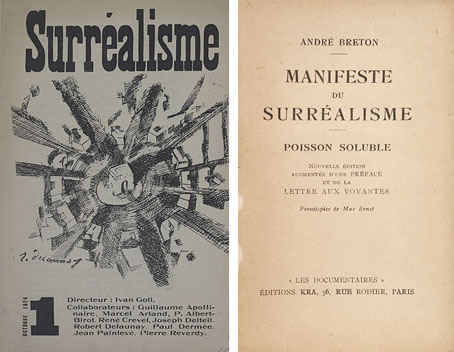
As I was saying a couple of weeks ago, Surrealism will be 100 years old this year, if you mark the movement’s birth from the first manifestoes (there were two different ones) published in October 1924. Surrealism doesn’t really have a definite beginning, however, either in 1924 or earlier on; the movement evolved over several years, with different factions competing for followers while squabbling over intentions. After a great deal of ferment the manifestoes from the opposed groups led by Yvan Goll and André Breton were a declaration that something substantial had been happening that required definition. I’m not sure why all of this interests me as much as it does just now, but I’m looking forward to seeing where the interest leads. Don’t be surprised to see more posts on the subject in the coming months.
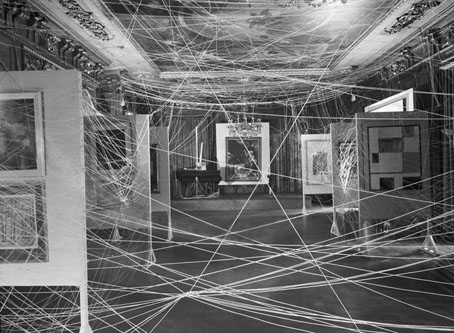
So, then… Fast-forward to 1942 and First Papers of Surrealism, an exhibition of paintings staged in New York City by the Coordination Council of French Relief Societies in October of that year. The exhibition was curated by André Breton with the assistance of Marcel Duchamp, Breton having recently arrived in the United States after escaping from Nazi-occupied France together with a small group of Surrealist artists, some of whom were represented in the show. Duchamp’s main contribution was His Twine, an installation of a large quantity of string threaded around the exhibition space through which the visitors had to peer in order to see the paintings. Duchamp also invited a group of children to play ball games inside the gallery on the opening night. This wasn’t the first Surrealist exhibition to be held in New York—Julien Levy had introduced the city to the latest art movement at his own gallery in 1933, and had been showing Surrealist paintings and Joseph Cornell’s artworks in the years that followed—but First Papers on Surrealism was an important event, with many major artists represented.
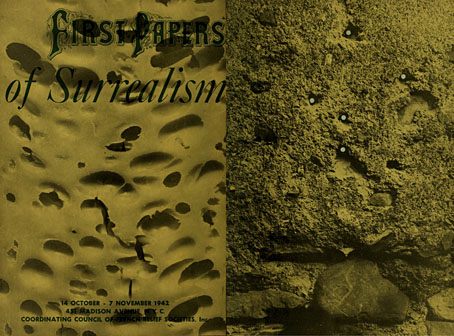
What you see here are pages from the exhibition catalogue, a publication which is more like one of the smaller Surrealist magazines than a mere list of the pictures on display. Marcel Duchamp designed the die-cut cover (those holes make me wonder whether these were also originally threaded with string), while the catalogue interior contains an intriguing collection of quotes, captions, photographs and illustrations. Breton’s “Great Transparent Ones” raise their invisible heads again, while the artists and curators are all depicted in a series of “compensation portraits” which stand in for an absence of suitable photos.
Two things are worth noting about this publication. The first is the amount of occult imagery, not an unusual thing in the Surrealist context but an interest I always enjoy seeing reinforced. The Bretonian form of Surrealism is generally framed as Marxist on the one hand and Freudian on the other, a pair of ideologies usually regarded as antagonistic towards metaphysics or magical philosophy. (Freud declared to Jung that psychoanalysis had to assume a dogmatic form in order to protect itself against occultism’s “black tide of mud”.) Breton, however, was a poet before he was a dialectical materialist, and the Surrealist preoccupation with myth, with transmutation, and that mysterious quality that Breton termed “the Marvellous” finds a mirror in the Hermetic Arts. It’s curious that the complaints made by art critics about the Theosophical roots of abstract art—roots that aren’t always evident in the paintings they inspired—have never been applied to Surrealism when the occult enthusiasms are so obvious. A page in the catalogue bearing the heading “La Pierre Philosophale” (“The Philosopher’s Stone”) includes an illustration from a volume by Paracelsus, the occultist that Breton chose as the Magus of Locks in the reconfigured deck of Surrealist playing cards. The facing page has a Tarot card pasted over a Picasso painting. Tarot was a persistent Surrealist preoccupation: two years after First Papers of Surrealism, Breton published Arcanum 17, a book named after the Tarot trump of The Star, while one of the artists featured in the exhibition, Leonora Carrington, spent several years painting her own interpretation of the Major Arcana. Another of the exhibition artists, Kurt Séligmann, went deep enough into occultism to write entire histories of Western magic. In an article on the subject for View magazine, Séligmann quotes a letter from Max Ernst in which the latter describes magic as “the means of approaching the unknown by other ways than those of science and religion”. Ernst’s definition could, of course, just as well apply to art; the two disciplines are entangled like Duchamp’s twine.
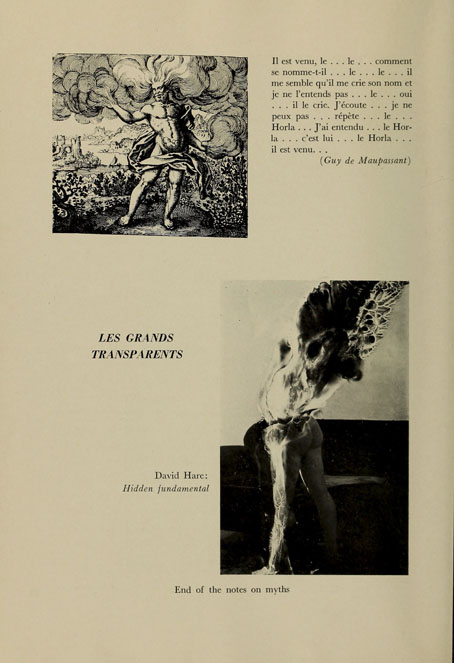
The second thing of note in the catalogue is a detail that wouldn’t mean a lot to many art historians but it almost made me exclaim aloud. Robert Allerton Parker’s introductory essay, Explorers of the Pluriverse, ends with a paragraph of praise for one of the princes of the weird tale, Clark Ashton Smith. “I came by chance upon his black bitter humour in the pages of a pulp-paper magazine devoted to quasi-scientific fiction,” says Parker, although he doesn’t mention the name of the story that caught his attention, or the title of the magazine. (It may have been Wonder Stories, where Smith published his more “quasi-scientific” tales.) Parker’s essay also mentions Edgar Allan Poe and the historical anomalies collected by Charles Fort. Parker expanded on his enthusiasm for “pulp-paper magazines” the following year in another essay, Such Pulp as Dreams are Made On, written for André Breton’s VVV magazine, an article that draws the fiction of Smith and HP Lovecraft to the attention of a Surrealist-adjacent readership. If we had access to complete scans of VVV (and View, and Minotaure, etc) I wouldn’t have had to wait this long to find out that The Call of Cthulhu and The City of the Singing Flame had been quoted in the pages of a Surrealist magazine in 1943. Maybe I shouldn’t wonder so much about my abiding interest in Surrealism after all. It’s connections like these that make the movement impossible to ignore.
Elsewhere on { feuilleton }
• The Surrealism archive
Previously on { feuilleton }
• The Great Transparent Ones
• The Execution of the Testament of the Marquis de Sade by Jean Benoît
• Chance encounters on the dissecting table
• The Marvellous
• Surrealist cartomancy

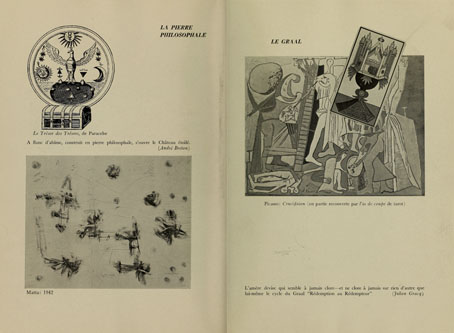
As fallout from the recent exhibition in Chicago, the folks at Wakefield Press have announced an expanded version of Remedios Varo’s writings to be published in April, newly entitled Homo Rodans and Other Writings. The volume will include a newly discovered interview and three previously unpublished short stories.
The exhibition catalog, Remedios Varo: Science Fictions, is really excellent. There is a chapter devoted to her personal library which included many science fiction and fantasy titles. She was an Isaac Asimov fan and read science popularizers like Fred Hoyle.
Great piece. I love old exhibition catalogues. And I wish Taschen (or some publisher) would come out with a reprinted compilation version of “Minotaure”, in the manner of their “Arts & Architecture” edition.
Stephen: I’m a little surprised she liked the hard SF guys, I’d have thought science-fantasy would be more to her taste. A lot of CAS’s SF has a fantastic, visionary quality, especially The City of the Singing Flame.
Jim: I wish someone would as well but I suspect all the issues will appear as scans at Gallica before anyone reprints them. Hard copies might be a hard sell, especially if the contents remained in French. If not, then they’d have to be translated and newly typeset. There’s also the copyright issues. With so many contributors you’d have to get clearance from many different estates. Book editors often complain about this when they’re putting anthologies together. Finding the owner of the rights to a minor text can be a difficult business.
Thanks for this, another fascinating and intriguing read – I had no idea that there was a Surrealism/CAS/weird pulps connection. That’s my kind of Venn diagram! And in one of those coincidences that our Surrealist friends would surely appreciate, I’m currently reading Nadia Choucha’s “Surrealism and the Occult”, which fits in with this very nicely.
Thanks, Ian, I ought to get the Choucha book. I have a PDF of another book with the same title by Tessel Baudin, one of those academic volumes that’s stupidly expensive if you want a paper copy. The writing (or translation) is a little erratic as well. The CAS reference is one of those connections that I love to find, something that most art historians would ignore, and only the very obsessive CAS readers would know about.
Roger Caillois was involved with the Surrealists in the early days, and later edited a number of collections of fantastic writing. He also mentions Lovecraft in his small book about the curious narrow buildings you find in the suburbs of Paris.
Such a marvellous post. Thanks for taking the time to put it together. The encyclopaedic catalogue for the 1978 exhibition Dada and Surrealism Reviewed at the Hayward Gallery also includes mention of their enthusiasms for the fictional weird, the book containing a tantalising reference to the Explorers of the Pluriverse article. The tome also lists a couple of texts by Lovecraft too, included in the show as ‘chosen objects’. If you don’t have it already, I’d recommend acquiring a copy of this strange all-encompassing volume (mine, a ex-library copy purchased cheaply, came marked RETURN TO THE SUB-BASEMENT. From the mildewed pages arose the subterranean scent of the deeply weird).
Toby: Thanks for the tip, that’s another one to go looking for. The Arena episode about Surrealism with George Melly was prompted by the Hayward exhbition but it’s more about Melly’s own interests:
https://www.youtube.com/watch?v=cIG0ahCinSo
I saw another Surrealism show at the Hayward in 2006 which was pretty good, although not as extensive.
There’s actually a list in the catalogue of the books in Varo’s library when she died. Besides volumes one would expect from Jung, Gurdjieff, Ouspensky, and Yogananda Parahamsa, Varo had Bradbury, Huxley, Poe, Wells and Verne. Yep there are two volumes of HPL translated into French, and the original French publication of Pauwels’ & Bergier’s Morning of the Magicians>.
Thanks! I can imagine the Pauwels & Bergier being popular with many of the Surrealists, that book is almost a Surrealist object itself.